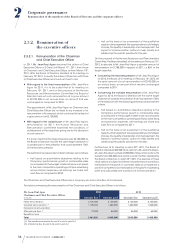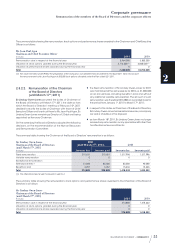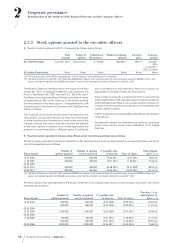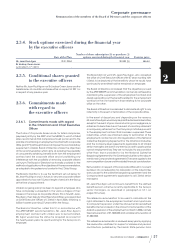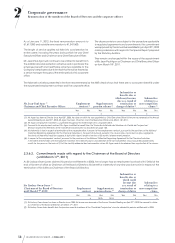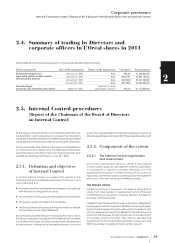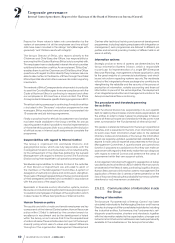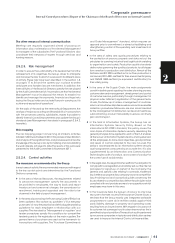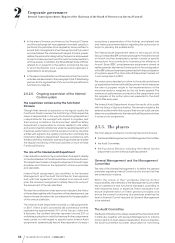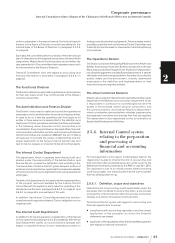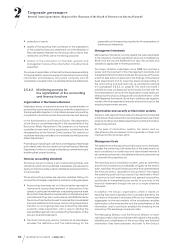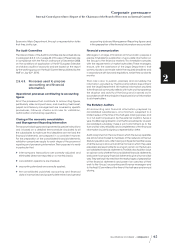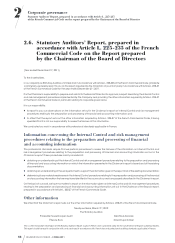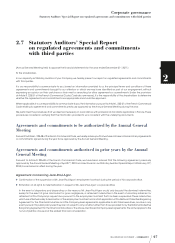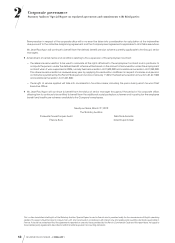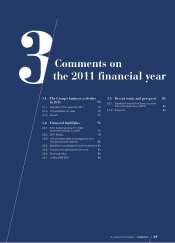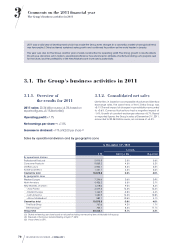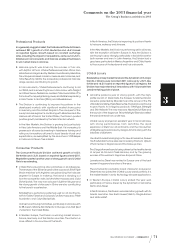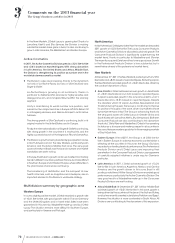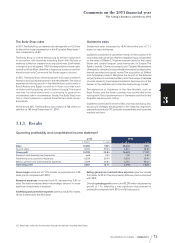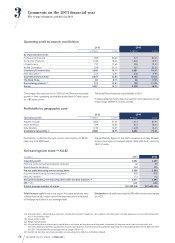Loreal 2011 Annual Report Download - page 66
Download and view the complete annual report
Please find page 66 of the 2011 Loreal annual report below. You can navigate through the pages in the report by either clicking on the pages listed below, or by using the keyword search tool below to find specific information within the annual report.
64 REGISTRATION DOCUMENT − L’ORÉAL 2011
2Corporate governance
Internal Control procedures (Report of the Chairman of the Board of Directors onInternal Control)
♦protection of assets;
♦quality of the reporting that contributes to the preparation
of the published financial statements and the reliability of
their centralised treatment for the Group with a view to their
distribution and their use for monitoring purposes;
♦control of the production of financial, general and
management accounting information including fraud
prevention.
The scope of application of Internal Control procedures relating
to the preparation and processing of financial and accounting
information encompasses the parent company and all
subsidiaries included in the consolidated financial statements.
2.5.4.2. Monitoring process for
theorganisation of the accounting
and finance functions
Organisation of the Finance Divisions
Dedicated teams of specialists ensure the implementation of
accounting and financial monitoring, under the supervision of
the General Management, in the following areas: accounting,
consolidation, financial control, financial services and treasury.
In the Administration and Finance Division, the preparation
of the Group’s consolidated results is the responsibility of the
Economic Affairs Department. The presence of a financial
controller at each level of the organisation contributes to the
strengthening of the Internal Control system. This network of
subsidiary financial controllers is co-ordinated by the Economic
Affairs Department.
Processing and pooling of cash flows and hedging of exchange
and interest rate risks are carried out by the Financial Services
Department, which is in charge of identifying commitments and
enabling their proper booking.
General accounting standards
The Group has put in place a set of accounting policies and
standards, which all consolidated subsidiaries are required to
apply and which enable uniform, reliable financial information
to be provided.
These accounting policies are regularly updated, taking into
account the changes in regulations and accounting principles.
♦Accounting standards set out the principles required for
harmonised accounting treatment of transactions. They
specify in particular the methods of recording balance sheet
items and of identification and valuation of off-balance sheet
commitments. They are in accordance with IFRS standards,
the accounting standards used to prepare the consolidated
financial statements. The Group’s Accounting Department
monitors, on an ongoing basis, new accounting standards
currently under preparation, with a view to alerting the
General Management and anticipating their effects on the
Group’s financial statements.
♦The chart of accounts, which is common to all subsidiaries,
provides the definitions and the methodology for the
preparation of the reporting required for the preparation of
the financial statements.
Management standards
Management standards not only specify the rules applicable
to the valuation of certain significant accounts in the Balance
Sheet and the Income Statement but also the controls and
validations applicable to the key processes.
The major initiative undertaken since2008 has involved a
review and improvement of the management standards and
the related Internal Control procedures. The purpose of this work
is both to take action in response to the findings of the Internal
Audit Department and to cover the areas corresponding to
the accounting and financial risks of subsidiaries referred
to in paragraph2.5.2.3. on page61 . This work has made it
possible to bring our approach more closely into line with the
recommendations set out in the “Application Guide relating to
Internal Control of accounting and financial information” of the
AMF Reference Framework. Since then, additions are regularly
made to the management standards and are thus part of the
ongoing improvement process.
Organisation and security of information systems
Decisions with regard to the choices of software that is adapted
to the Group’s financial and accounting requirements are made
jointly by the Economic Affairs Department and the Information
Systems Department.
At the level of information systems, the teams work on
strengthening the procedures for the separation of tasks and
improved control of access rights.
Management tools
The system for monthly reporting of various economic indicators
enables the monitoring of the evolution of the performance of
each subsidiary in a continuous and harmonised manner. It
also enables assurance to be obtained that such performance
is in line with the objectives set.
The reporting and consolidation system, used by all entities,
ensures the consistency and reliability of figures at the level of
each subsidiary through blocking controls that operate before
the financial data is uploaded to Group level. In this regard,
the operating profit and loss account by destination, which
is common to both management and general accounting,
contributes to strengthening the control of accounts in the
financial statements through the use of a single reference
framework.
In addition, the Group’s organisation, which is based on
reporting from each subsidiary that is provided directly by the
countries to the parent company, without any intermediate
aggregates for the vast majority of the subsidiaries, enables
optimisation of the data transfer and the completeness of the
information, and in particular enables the checking of the
accuracy of the exchange conversion rates.
The Managing Director and the Finance Director of each
subsidiary make a joint commitment with regard to the quality,
reliability and completeness of the accounting and financial
information they have prepared and sent to the Group’s


